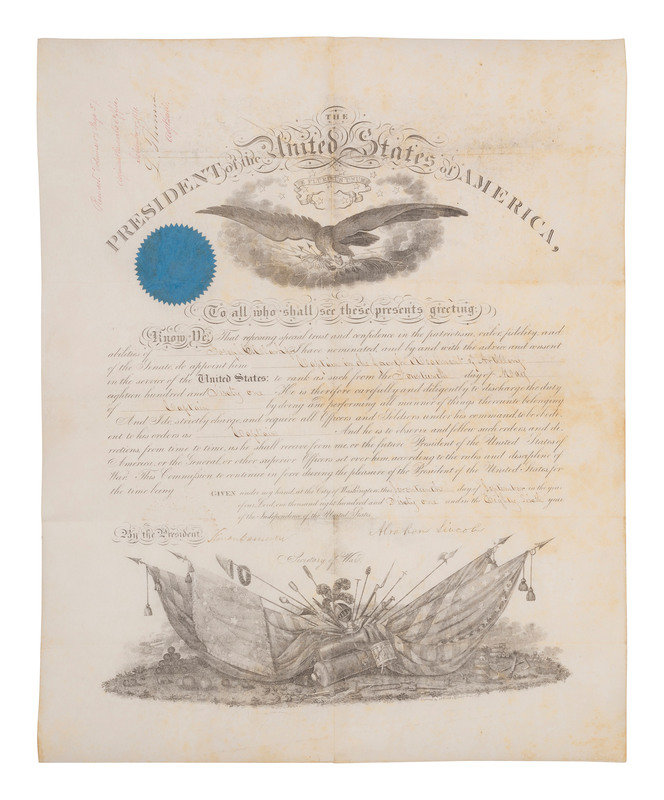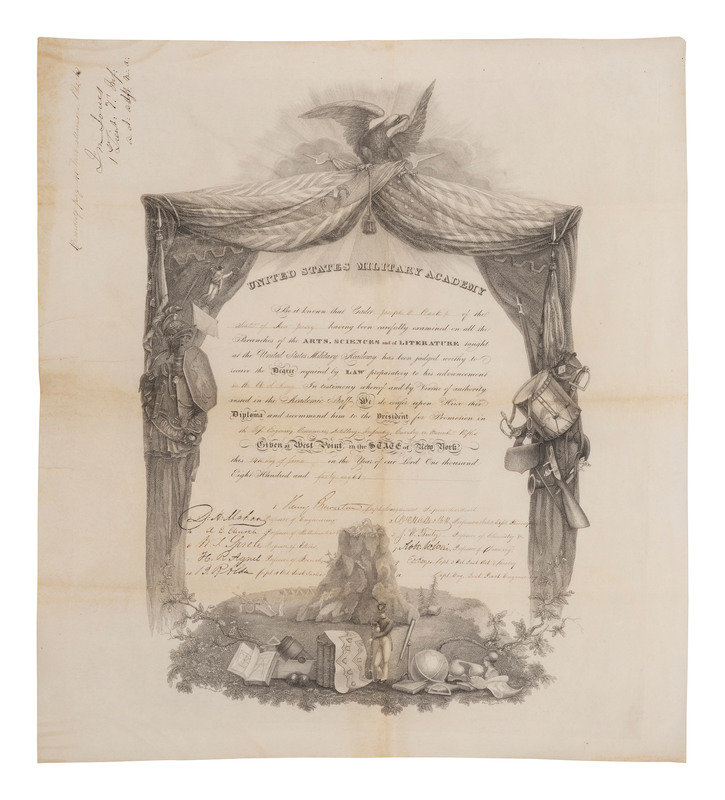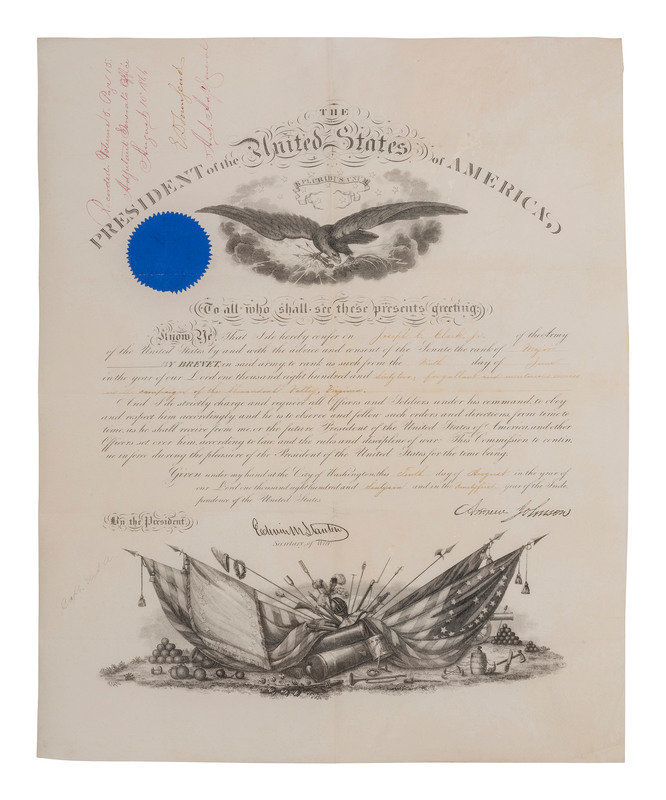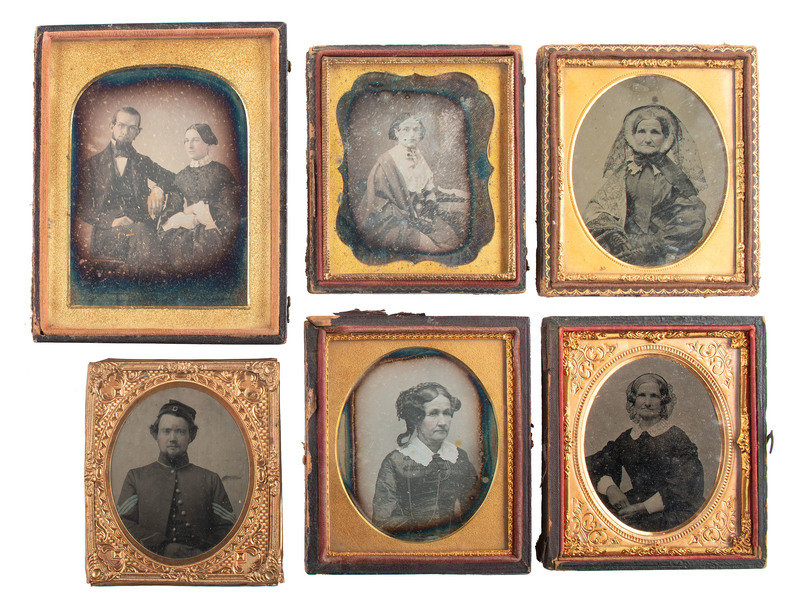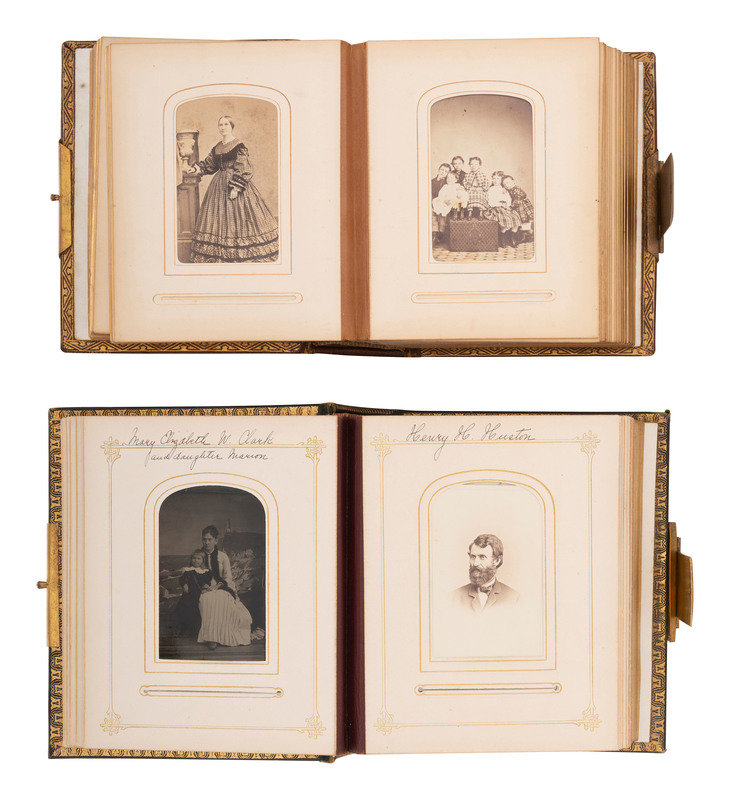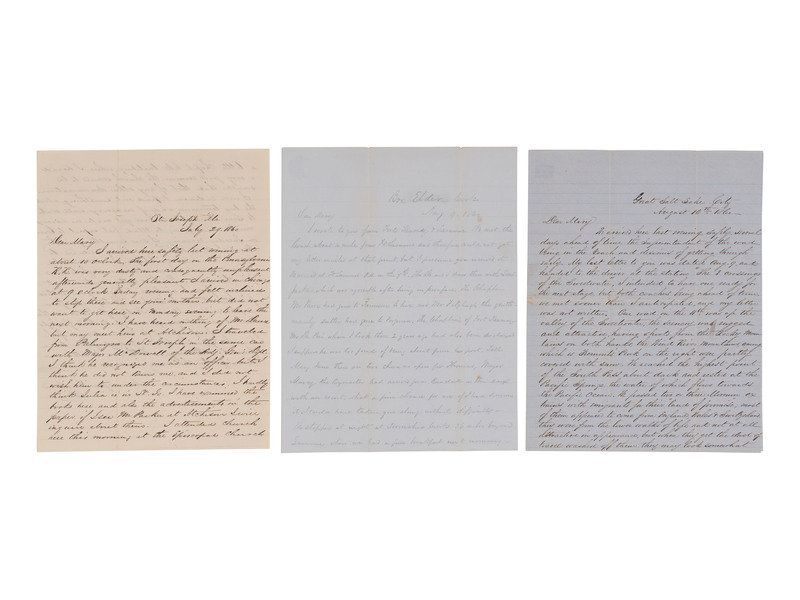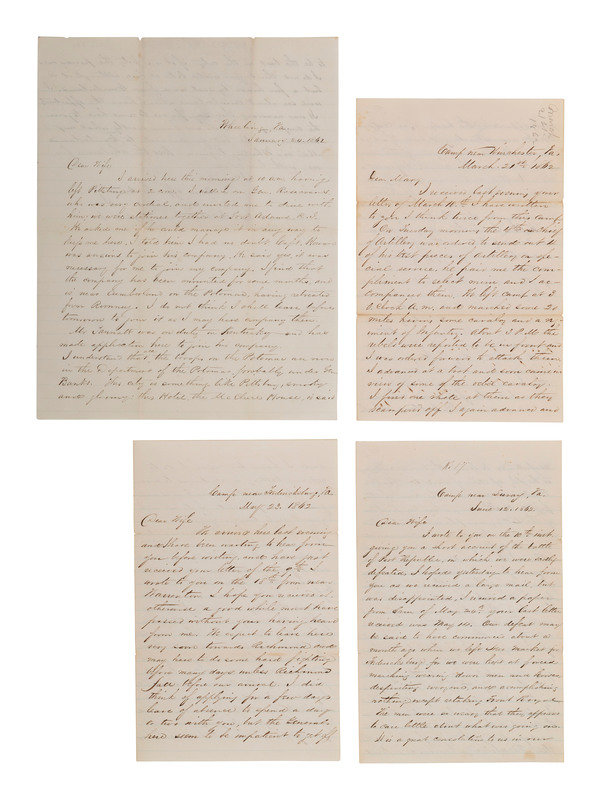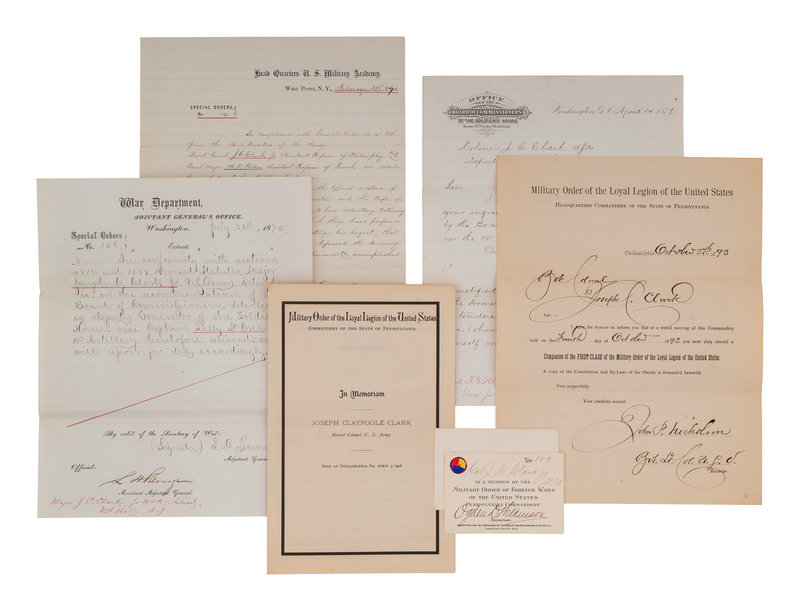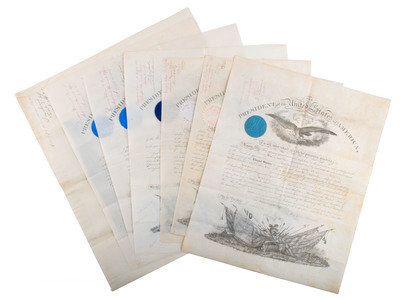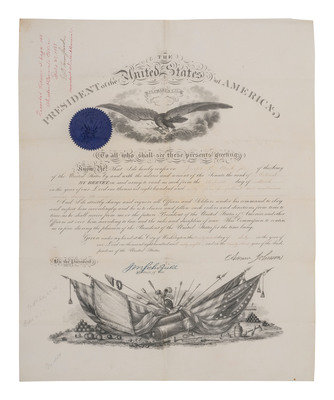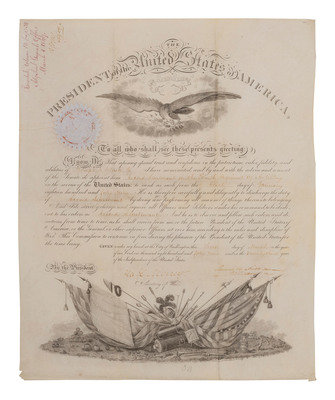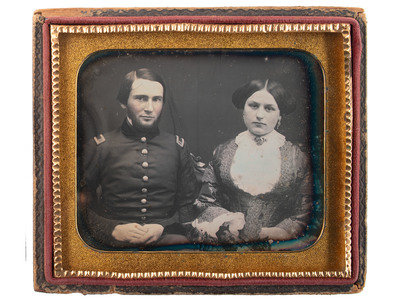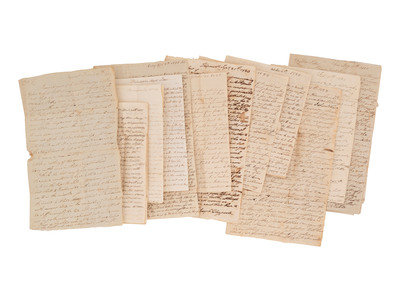Lot 130
Archive of approximately 200 items items spanning ca 1815-1940s (bulk 1840s - 1890s). Collection highlighted by 87 letters written by Joseph Claypoole Clark, Jr. (1825-1906) between 1860-1862 while serving in US Army frontier garrisons and with the 4th United States Light Artillery in the Eastern Theater, and by Clark's military commissions signed by Presidents Lincoln, Johnson, Polk, and Fillmore. Accompanying the letters and documents is a large group of historic photography, comprising: 8 cased images, 8 CDVs, 2 cabinet cards, and 2 CDV albums containing an additional 63 images, many of which are identified members of the Clark family and descendants. Among the images are a sixth plate daguerreotype portrait featuring Clark in uniform, two Civil War-era CDVs of Clark in uniform, and a CDV of Clark's wife, Mary Eliza Goodell Clark (1832-1890), the recipient of the majority of Clark's letters. Clark's correspondence initially housed in a japanned box, 14 1/4 x 10 1/4 x 6 1/4 in., which also contained additional letters and documents related to the Claypoole and Clark families and later descendants. Condition of Clark's letters generally very good, with clean pages exhibiting expected toning and folds, and legible writing accomplished in pencil and ink. Provenance: Archive appears to have descended from Clark to his daughter Josephine Kille (Clark) Kingston.
A UNIQUELY SUBSTANTIVE ARCHIVE WITH SCARCE WESTERN CONTENT.
Having previously served garrison duty in locations across the country, 1st Lieut. Joseph Claypoole Clark, Jr. found himself in St. Joseph, Missouri, on 29 July 1860 headed westward once again. St. Joseph was a launching point for the journey west for hundreds of thousands of settlers in the mid-19th century, and Clark was preparing to embark upon the main Oregon/California/Mormon Trail through Wyoming and then on to his final destination, Camp Floyd (later renamed Fort Crittenden), Utah Territory. Clark's first three letters in the archive discuss in detail his journey along the trail, painting a vivid picture of the experience.
Writing to his wife from "Box Elder Creek" on August 9 and 10, 1860, Clark describes the stop at Fort Laramie and several subsequent locations with iconic trail landmarks: "We left Box Elder Creek yesterday, crossed Deer Creek where there were about 100 lodges of Oglala Sioux Indians assembled to receive their annuities. We stopped at Platte Bridge. The trader there had torn down all the principal buildings to get material to rebuild his establishment and for fuel. The post presented a rather desolate appearance, nothing standing but a few out buildings and chimneys. Proceeding on we crossed the North Platte, passed the 'Red Buttes' a red rocky formation, and stopped at the Sweet Water Bridge after day light making 95 miles. I regretted riding after dark as I wished to see the scenery. We left this morning after partaking of a poor breakfast ascended the valley of the Sweet Water, passed 'Independence Rock' a huge oblong bubble of rock where many fools have inscribed their names. Devil’s Gate a deep cut of perhaps 125 feet in the solid rock, through which flows the Sweetwater. It looks unnatural as the water could not have worn it away, but would have turned aside to seek a channel around the base of the rock." As is typical of Clark's style, he continues with news of those he encountered along the way: "We met the mail stage at noon and brought it back to our resting place for the night as the agent had some business to transact. Lieut. Hill of the Infantry was on his way to Laramie from Camp Floyd. Col. Cooke’s command was at Bridger, with him was Capt. Clarke, Capt. Gibbon & family, Lieut. Morgan & family, and Lieut. Beach. The battery company had not returned to Camp Floyd, but was at Ruby Valley 160 miles west, would not probably be in much before Oct. 1. I will probably be in Camp Floyd before Col. Cook’s command." His next letter written 16 August 1860 from "Great Salt Lake City" describes the rest of his journey and arrival in the Mormon city: "Our road on the 11th was up the valley of the Sweetwater; the scenery was rugged and attractive.... We passed two or three Mormon ox trains with immigrants for their land of promise'; most of them appeared to come from England, Wales & Switzerland. They were from the lower walks of life and not at all attractive in appearance, but when they get the dust of travel washed off them, they may look somewhat better. We left Pacific Springs on the 12th and went to the crossing of Green River about 65 miles. We passed a Mormon hand cart train of about 40 carts, pulled and pushed by the emigrants; there were generally 4 or 5 to each cart and they appeared to get along smoothly though the road was good where we met them. A few mothers on foot were carrying babies in their arms; one woman was barefoot, and others had rags wrapped around their feet; most of them appeared cheerful, but a few seemed discouraged. It seems strange to see women well in the decline of life on such a pilgrimage. We passed the spot where the Mormons burned one of the supply trains of the Army; the marks of the fire are plainly visible and portions of the iron work of the wagons lying around.... We saw signs of suffering of the Army of 1857 & 8. In one place lay the bones of 1200 cattle that died of cold and starvation, and many thousands more lay along the road." He then continues describing entering Echo Cañon, and notes for the first time an encounter with a rider from the soon-to-be legendary Pony Express: "The Pony express rider passed us to-day and stated that the troops west of here (probably the battery company) had had a skirmish with the Indians and killed 18 of them, having 3 soldiers wounded." From there Clark describes the entry to East Cañon, passing through Emigration Cañon, and the view of the Great Salt Lake and city, indicating that the city was not "attractive in appearance."
By August 20, 1860, Clark has reached Camp Floyd describing it as "a rather dull looking place as far as the country is concerned in the immediate vicinity, there being but little vegetation; the houses are numerous but being built of adobes have a dull appearance, and are not so comfortable as those at Fort Randall." Constructed in 1858 in response to escalating troubles during the "Mormon Rebellion" or "Utah War," Camp Floyd housed the largest concentration of US troops to that time, and became immediately the third largest city in Utah. Over the course of his remaining frontier letters, Clark writes from Camp Floyd, Fort Crittenden, and later Fort Bridger, discussing his work and leisure activities, troop movements, promotions, military courts, sutlers, and fellow officers, with occasional references to Mormons and Native Americans. Additionally, Clark makes 17 references to the Pony Express whose operation from April 1860 through October 1861, coincides with Clark's letters. At its height, the Pony Express operated an estimated 190 stations, including at Camp Floyd/Fort Crittenden and Fort Bridger where Clark was stationed. Clark writes to Mary of the receipt of "a Pony despatch," "Pony news," and "word by Pony."
Clark's frontier letters span July - October 1860 (8 letters), then April 1861 - Dec 1861 (28 letters). A notable change in tone and content comes in the letters following this gap, as sectional tensions in the East have mounted and soldiers in the West learn of the outbreak of the Civil War. Clark discusses the war and his fellow officers, noting one by one as men declare their allegiances to the Union, or resign and return to fight for the emerging Confederacy. Writing on 19 May 1861 from Fort Crittenden: "We have Pony news to May 13th, it is hardly worth while to comment on it, as you have heard so much later news. By the last mail we received reports of the resignations of Capts. Magruder, Elzey & Anderson of the Artillery. I presume Capt. Brown will follow, and perhaps Capt. McCown & Getty. Should these take place I would be promoted to one of those companies. Capt. Gibbon seems to stand firm and appears in better spirits than he did and says that he will renew the oath of allegiance if required. Capt. Robertson stated that he would await the result of the vote of the state of Virginia and act according to that vote. He is in an unpleasant position, being a Unionist but unwilling to fight against his state." As the conflict in the East begins to escalate, Clark is ordered in the summer of 1861 to Fort Bridger to take charge of army stores. He applies to Washington in September 1861 to be ordered to his company fearing "that it might be thought [he] voluntarily remained away from actual service." Finally, on 30 November 1861, Clark writes from Fort Bridger that he has received his commission as captain. By mid-December he is making preparations to depart the fort, and his last letter to Mary from the West is written on 22 December 1861.
Clark's letters from the Eastern Theater span January 1862 -August 1863 (51 letters). A letter to Mary of 19 January 1862 (incorrectly dated 1861) indicates Clark is on his way to the front. The following day he writes from Wheeling, Virginia, noting in his letter that he dined with General Rosecrans with whom he had been stationed at Fort Adams, Rhode Island earlier in their careers. By 23 January 1862, Clark has joined the 4th United States Artillery, Battery E, at Camp Kelley, Patterson's Creek, VA. As part of Shields' 2nd Division, Banks' 5th Army Corps, Clark and Battery E would participate in their first major engagement at the Battle of Winchester (March 23, 1862), a battle described by Clark in two letters of March 25th and March 27th. On the 25th Clark writes, in part: "We left camp on Sunday not expecting a serious conflict, but it soon became evident that the enemy were in force. We had four batteries and the rebels about the same number, my battery had the most advanced position and evidently annoyed the enemy exceedingly as he fired probably more shots at us than at all the other batteries....I lost but one man killed 3 horses disabled, and one gun carriage injured. The infantry suffered severely in the charge on one of the enemies battery's, where they captured two guns...." Then on the 27th, he writes from "Camp near Strasburg, Va" with more discussion of the battle, also indicating that though his company "is said to be favorably mentioned in the report of the Chief of Artillery," Col. Daum has however "endeavored to give greater credit to the four others [guns] which belonged to his battery before he was promoted."
On June 12 he writes describing the Battle of Port Republic (June 9, 1862), at which he led his battery in combat for the first time. In a detailed 4pp letter Clark argues first that the "defeat may be said to have commenced about a month ago when we left New Market for Fredericksburg for we were kept at forced marching wearing down men and horses, despiriting everyone, and accomplishing nothing...." He then continues at length describing his movements during the battle, and indicating, "The wing where my portions of the battery was placed was badly managed by Gen. Tyler in command.... The rebels were allowed to approach in great force to within a few yards of our guns through the woods unseen by us. The Infantry which he should have had there to guard and protect us had either been withdrawn or retreated without giving any intimation of the approach of the rebels...."
Regular correspondence to Mary references ongoing engagements as his artillery participates in Pope's Campaign in Northern Virginia, including writing on 26 August 1862 of his part at Kelley's Ford on the Rappahannock and on 3 September of his battery's part in the 2nd Battle of Bull Run. (Aug 30, 1862), a battle he believes was horribly mismanaged and which seems to have painfully impressed upon Clark the enormity of loss and struggle ahead. He writes on 4 September, "The cause of the Union appears now darker than at any previous time.... How many men, many of them useful citizens, have suffered during the last week is is painful to contemplate...." September 10, 1862, marks the end of Clark's war-date field correspondence. On September 17, 1862, Captain Clark commanded a battery of 59 men at the Battle of Antietam until he was severely wounded three times in the leg and once in the hand from shrapnel from exploding artillery shell. In the Brigade commander's after-action report, he noted: "...I cannot refrain, however, from speaking of Captain Clark, of Battery E, Fourth Artillery, who did excellent service, and received four wounds during the day...." After eight months of recovery from the wounds he received at Antietam, Clark was found medically unfit for field service. He was then detailed as an assistant professor of Natural and Experimental Philosophy at West Point in August 1863. The archive contains a letter to Mary, dated 12 August 1863, written from West Point, the final letter of Clark's war-date correspondence.
[With:] Sixth plate daguerreotype likely showing 1st Lieutenant Joseph Claypoole Clark seated next to his wife, Mary Goodell Clark, and wearing the shoulder straps of a first lieutenant on regulation (1851) single-breasted nine button frock coat suitable for a junior or company grade officer, c.1852-54. This date is predicated upon the higher uniform collar perceived in the photograph and corroborating the earlier style of brass daguerreian hardware. The shoulder straps coincide with the date of Clark's appointment to First Lieutenant, 4th Artillery, on 11 December 1850, a rank which he retained until promotion in 1861. Clark married Mary Eliza Goodell in Oswego, New York, 8 November 1852, suggesting this portrait may have been made on the occasion of their wedding. -- An additional 6 cased images of unidentified individuals, consisting of 1 quarter plate, 4 sixth plates, and 1 ninth plate. -- A group of 8 CDVs, comprising: a CDV of Clark in uniform ca 1850s, 2 CDVs of Clark in uniform, ca 1861-1862; a post-war CDV of Clark; 2 CDVs of Clark's son, William Goodell Clark (1853-1936); a CDV of Mary Goodell Clark; and a portrait CDV of two individuals, likely extended Clark family members. -- Tintype of an unidentified soldier in Union uniform with blue chevrons of an infantry sergeant. -- A group of 2 cabinet cards, one showing Joseph Claypoole Clark, Jr., and another showing his father, Joseph Claypoole Clark, Sr. (1796-1881). - A group of 2 CDV albums featuring mostly CDV portraits, many identified.
[With:] Documents associated with Clark's appointment to West Point, comprising: an ALS by New Jersey Congressman George SYKES (1802-1880), Washington, 13 March 1844; a DS by Secretary of War William Wilkins notifying Clark of his conditional appointment as a cadet and instructing him to repair to West Point between the 1st and 20th of June 1844; a DS by Secretary of War William Wilkins officially acknowledging the President's appointment of Joseph C. Clark as a cadet in the service of the United States, 30 June 1844; a letter written from Clark to his father on 21 June 1844 shortly after his arrival at West Point; a manuscript entitled "Benny Haven's O / A souvenir for graduates of the Military Academy," ca 1848; the "Official Register of the Officers and cadets of the U.S. Military Academy, West Point New-York" for the years 1844-1848; and Clark's West Point diploma, 24 June 1848. -- A small group of post-war documents associated with Clark and his military service, including the order relieving Clark of his professorship at West Point, 21 February 1870; a copy of the order recommending Clark for a position at the Soldier's Home, 31 July 1875; a notice of the resignation of Clark as Deputy Governor of the Soldier's Home, 16 April 1877; a document notifying Clark to his election as a Companion of the First Class of the Military order of the Loyal Legion of the United States, 5 October 1893; and Clark's "In Memoriam" program, MOLLUS, ca 1907.
[Also with:] Genealogical research and documentation associated with both the Claypoole, Clark, and Goodell families, and 2 family Bibles. -- A small amount (approx. 75 pieces) of personal correspondence and other documents, some dating as early as ca 1815 and other pieces 20th-century in origin, associated with members of the Claypoole, Clark, Kingston, and Edgell families. -- A coin silver soup ladle with the hallmark of Philadelphia silversmith "Brasier," 190.5g, engraved "E.C." (likely for Elizabeth Clark) and "1890." -- A group of 26 ca 19th-century dominos and a japanned storage box.
Joseph Claypoole Clark, Jr. was born in Mount Holly, New Jersey. He was a descendant through his paternal grandmother (Ann Claypoole, 1764-1832) of the prominent Claypoole family of Philadelphia. In 1848, he graduated from West Point ranking 9th out of 43 cadets, and embarked upon a career in the military. During the late 1840s and 1850s, Clark was stationed throughout the country, serving on garrison duty and with the United States Coastal Survey. In 1858 Clark embarked upon frontier duty, first at Platte Bridge, then Fort Laramie, Fort Randall, and finally at Forts Crittenden and Bridger. He was promoted to captain in May 1861 and recalled to the East later that year. Following his Civil War service with Battery E, 4th US Artillery and his subsequent injury on 17 September 1862 at Antietam, he retired from active service on 11 May 1864 with rank of Major for "Disability for Wounds Received in Battle." Clark, who had previously taught mathematics at the United States Military Academy, was assigned to West Point in 1863 as Principal Assistant Professor of Natural and Experimental Philosophy. He remained there until 1870. He later served as Professor of Military Science at the University of Pennsylvania and Deputy Governor of the Soldiers' Home, near Washington, D. C. Throughout his later years, his wounds from the Battle of Antietam continued to prove debilitating. He died in Philadelphia in 1906.

